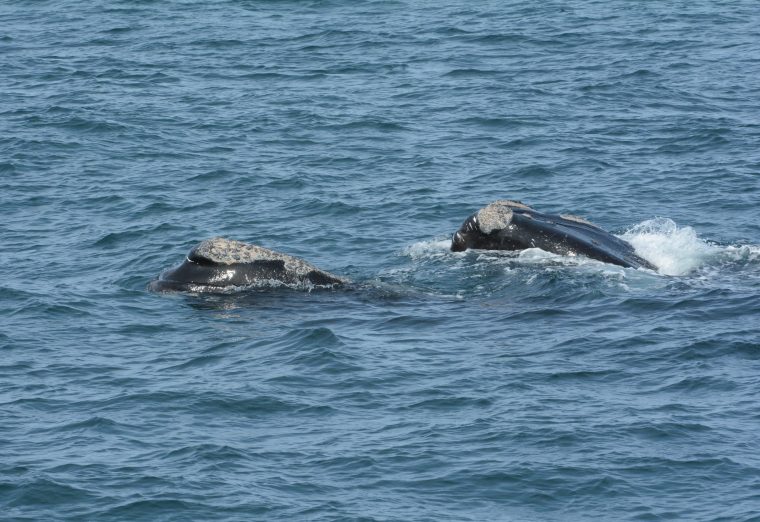Boat survey teams, along with long-standing Aquarium aerial survey team, sight more than 20 right whales during winter field work, aiming to better understand climate change impacts

BOSTON, MASS. (March 9, 2022) – For the first time ever, New England Aquarium scientists are surveying the waters of southern New England by boat in addition to long-time aerial surveys to better understand how critically endangered North Atlantic right whales are increasingly using this habitat amid climate change.
**PHOTOS AVAILABLE HERE—PLEASE SEE CAPTION AND CREDIT INFORMATION**
From mid-January to early March, researchers spent a total of four days on the water approximately 70 miles south of Nantucket, searching for right whales to document. Their work focused on capturing detailed lateral photographs used to assess the health and scarring of the animals, as well as collecting tissue and fecal samples to analyze the whales’ reproductive status and stress level. Concentrating boat-based field work in southern New England is a direct response to climate change. In the past 12 years, the area has become an important habitat for the species as climate change has led to a shift in where right whales feed off the northeast U.S. and Canada. There has been very little boat-based right whale research in southern New England, none in the winter months.
“Climate change requires us to adapt our research study areas just as the whales have changed their feeding areas,” said Philip Hamilton, Senior Scientist in the Aquarium’s Anderson Cabot Center for Ocean Life. “There is an exciting sense of discovery surveying a new area and learning about right whales’ behavior there. After all these years, we still have much to learn about the species.”
During field work on Jan. 24, Jan. 27, March 1, and March 5, researchers sighted 17 individual right whales by boat, or 5% of the population which is estimated to be less than 350. Aquarium scientists worked in tandem with the New England Aquarium aerial survey team, as well as with teams from the Center for Coastal Studies and the Northeast Fisheries Science Center, which helped navigate the boat to whale sightings. In total, the Aquarium teams identified 21 unique right whales from either the air or the water.
“Our aerial survey plane flew several tracklines covering a large area south of Nantucket where our vessel team was planning to survey. We were then able to send the locations of our right whale sightings to the vessel to help direct their efforts,” said Katherine McKenna, a Research Assistant in the Aquarium’s Spatial Ecology, Mapping, and Assessment (EcoMap) Program. “The New England Aquarium conducts monthly aerial surveys south of Martha’s Vineyard and Nantucket, so we were excited to have an opportunity to overlap with the vessel surveys this month and provide support to our right whale research team.”
Working in southern New England waters in winter holds many challenges. Over a four-week period, there were just four days with winds low enough to be able to safely locate and photograph whales. Researchers also contended with fewer daylight hours. Additionally, the whales’ surfacing behavior in the area during this time of year is infrequent and erratic, likely as they feed below the surface and travel through the waters.
“Winter weather is very dynamic and hard to predict. Not only were we looking for nice weather at sea, but we also had to plan around snow storms so that our team could travel to and from the boat safely,” said Research Assistant Amy Warren of the Aquarium, who managed logistics for the March field work. “The southern New England area is quite large, and given how spread out the whales tend to be, it can feel very needle-in-a-haystack.”
Aside from their many entanglement scars, overall, the whales sighted looked healthy with clean, black skin and good body condition. As an example of their findings, on March 5, the boat-based team saw four whales in a surface active group: Accordion (Catalog #4150), Catalog #2940, Catalog #3390, and Catalog #4501. Accordion, a female of unknown age, has been seen exclusively around Cape Cod since the climate change distribution shift of North Atlantic right whales in 2010/2011. Another female of unknown age, #3390, has had just one calf since she was first sighted in 2003 and has shifted her summer feeding into the Gulf of St. Lawrence in recent years. She has been entangled in fishing gear at least four times, based on photographic documentation.
The whales sighted on March 1, documented by both aerial and boat surveys, triggered NOAA to issue voluntary slow speed zones, called DMAs (dynamic management areas), for mariners to reduce their speed to 10 knots in an effort to protect the whales. The current DMA is in effect until March 17.
“This inaugural field work was a learning experience for all of us. The days are long and exhausting, the weather conditions unpredictable, and we did it amid the challenges presented by COVID. I can’t imagine how much harder it all might have been without any aerial support, so we are grateful to have such a strong partnership in this research,” said Associate Scientist Monica Zani, who oversaw the Aquarium’s field work in late January.
For more than 40 years, the New England Aquarium has extensively researched and tracked North Atlantic right whales, among the rarest whales in the world. In collaboration with an extensive network of individuals and research organizations along the eastern seaboard, Aquarium scientists curate the North Atlantic Right Whale Catalog. By collecting photos and cataloging the natural markings on whales such as callosities (raised tissue on their skin), Aquarium scientists identify whales by name and specific numbers to track their life stories including births, injuries, migration patterns, and age to create detailed histories of each individual whale.
MEDIA CONTACT:
Pam Bechtold Snyder – psnyder@neaq.org, 617-686-5068
